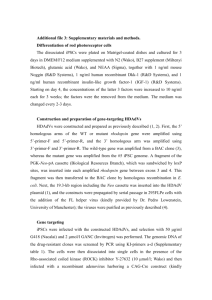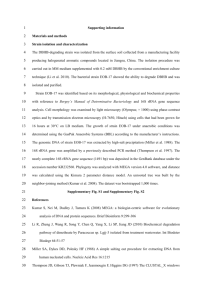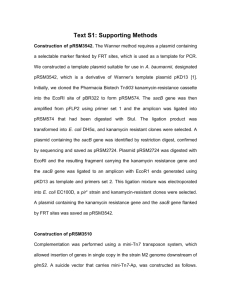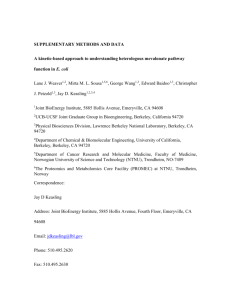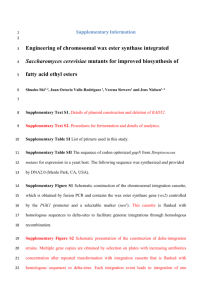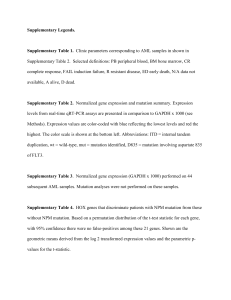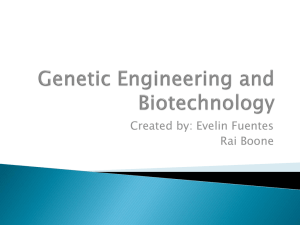bit25239-sm-0001-SuppData-S1
advertisement
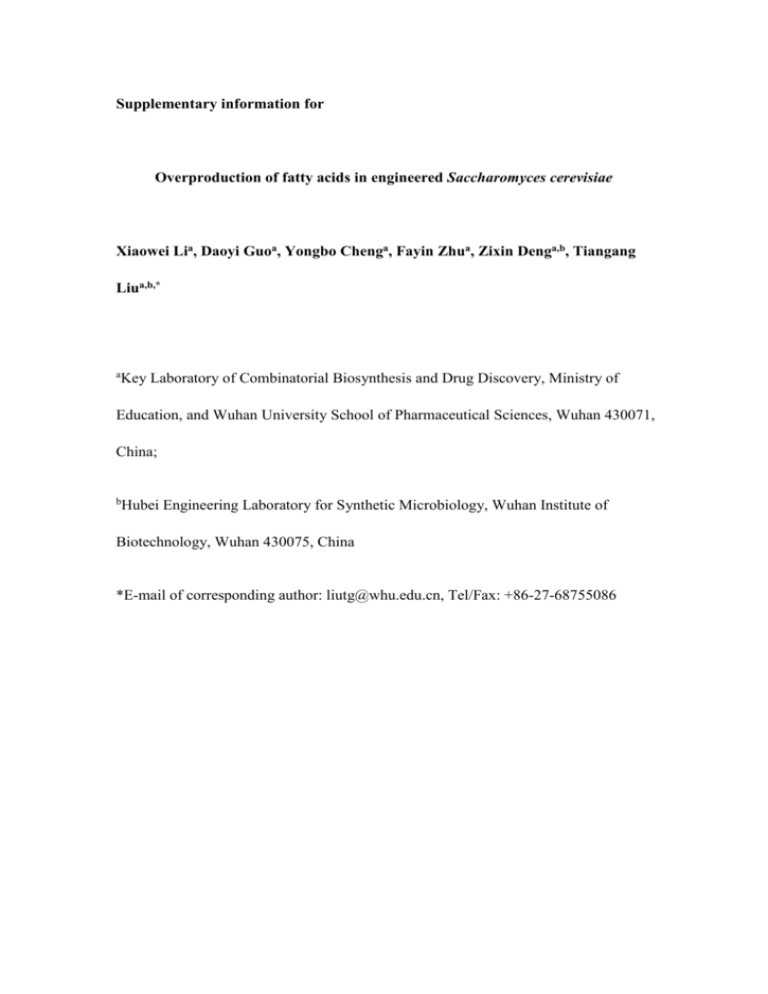
Supplementary information for Overproduction of fatty acids in engineered Saccharomyces cerevisiae Xiaowei Lia, Daoyi Guoa, Yongbo Chenga, Fayin Zhua, Zixin Denga,b, Tiangang Liua,b,* a Key Laboratory of Combinatorial Biosynthesis and Drug Discovery, Ministry of Education, and Wuhan University School of Pharmaceutical Sciences, Wuhan 430071, China; b Hubei Engineering Laboratory for Synthetic Microbiology, Wuhan Institute of Biotechnology, Wuhan 430075, China *E-mail of corresponding author: liutg@whu.edu.cn, Tel/Fax: +86-27-68755086 Supplementary Methods Molecular procedure The plasmid pUG6, which carries a gene-disruption cassette and kanamycin-resistant heterologous marker gene with loxP sites, was used for gene-disruption experiments(Güldener et al. 1996). The sequences that flanked the target gene were added to the both ends of the loxP-KanMX4-loxP cassette. There was a 40-nucleotide homologous sequence before the ATG start codon and one after the stop codon of the targeted gene. To delete ADH1, a 427-bp left-hand homologous fragment and a 374-bp right-hand homologous fragment were amplified from genomic DNA. Plasmid pSH47, which contained the Cre gene under the control of the GAL2 regulation promoter, was transformed and incubated in YP media with 20 g/L of galactose to eliminate the KanMX4 marker by Cre-loxP recombination and perform double-gene disruption. The plasmid pSH47 (URA3) was removed by streaking on a plate containing 5-fluoroorotic acid. The disruption cassette kanamycin-resistant heterologous marker was reused. Plasmid construction The accA, accB, accC, and accD genes were cloned into the NdeI-XhoI sites of plasmid pET28a to introduce an N-terminal His6 tag. The birA gene was cloned into plasmid pBBRIMCS1 behind the pT7 promoter. The pET28a plasmid was digested with NcoI and XhoI to obtain the sequence harboring the His6 tag, which was then cloned into the plasmid pYES2/NT. The ACC1 gene was cloned into the newly constructed plasmid at the SacI-NotI sites to introduce an N-terminal His6 tag behind the pGAL1 promoter. ACC2 was cloned into plasmid p424 at the BamHI-XhoI sites. The gene encoding plant thioesterase from Cinnamomum camphorum seeds (C. c TE) was amplified from pTL58 (Liu et al. 2010) and sub-cloned into the pDG001 vector behind the pTEF1 promoter. The truncated tesA gene, which lacked the leader sequence for periplasmic secretion, was amplified from pTL57 (Liu et al. 2010) and sub-cloned into the pDG001 vector. The PTE1 gene encoding thioesterase from yeast was amplified from the genome and sub-cloned into the pDG001 vector. The truncated PTE1 gene, which lacked the C-terminal AKF codon targeting the peroxisome, was also amplified from the genome and sub-cloned into the pDG001 vector. ACC1 was sub-cloned into the pDG001 vector behind the pHXT7 promoter. The eutE and adhE genes were amplified from the E. coli genome and sub-cloned into the pDG001 vector behind the pTEF1 promoter. The ADH2 gene was amplified from the S.cerevisiae genome and sub-cloned into the constructed vector with eutE behind the pHXT7 promoter. Product prepare for analysis Five milliliters of sample from the fermentation were extracted with 10 mL chloroform/methanol (1:1 v/v). Acetate (200 μL) and acid-washed beads (2 g) were added to the extract solution. Pentadecanoic acid was added as an internal standard. Fatty acids were extracted by vigorous vortexing for 10 minutes. After separating phases, the organic phase was collected and evaporated until dry. One milliliter of 5% (v/v) H2SO4 in methanol solution was added to each sample for lipid derivatization. After incubation at 90°C for 2 hours, total fatty acids from the lipid in yeast cells were converted primarily to fatty-acid methyl ester by transesterification. Later, 1 mL of 0.9% (wt/vol) NaCl was added to stop the reaction, and 350 μL of hexane was added to extract fatty-acid methyl ester. The solution was vortexed for 1 minute, and 200 μL of solution was collected for GC-MS analysis. Analysis of intermediates Cells were inoculated in 1000 mL fresh SC media (5% glucose as carbon source) with or without uracil in a 2000-mL Erlenmeyer flask. The initial OD600 was adjusted to 0.2, and approximately 3,600 OD cells were sampled during the exponential phase. All experiments were performed on the UFLC-System (Shimadzi) coupled with a QTRAP 4500(AB SCIEX). Separation was performed on Kinetex C18 columns (4.6×100 mm, Phenomenex). Solution A for HPLC of acetyl-CoA and malonyl-CoA consisted of 5.0mM ammonium acetate in water, which was adjusted to pH 5.6 with acetic acid. Solution B contained 0.1% formic acid in acetonitrile. The flow rate was 500 μL/min. And the chromatographic conditions were 2% B maintained for 2 min, ramped to 10% B within 2 min, held at 30% B for 1 min, and then return to 2% B within 1 min, and maintained at 2% B for another 5 min. Positive ESI-MS/MS mass spectrometry with a Turbo-spray source was performed with the following parameters: ion-spray voltage(IS) 5.5kV, temperature (TEM) 500 °C, collision gas (CAD) high, curtain gas (CUR) 10, ion-source gas 1 (GS1) 60, ion-source gas 2(GS2) 60, declustering potential (DP) 130, entrance potential (EP) 10, collision-cell exit potential (CXP) 13. Quantification was performed by MRM. The following reactions were recorded: 854.1-347.0 m/z and 854.1-427.9 m/z for malonyl-CoA and 810.1-302.9 m/z for acetyl-CoA. Extracellular metabolite analysis The concentrations of glucose, glycerol, acetate, and ethanol were determined by HPLC with an aminex HPX-87H ion-exchange column (Bio-Rad, Hercules, USA) and a refractive index detector. H2SO4 (5 m mol/L) was used for the mobile phase, and the flow rate was 0.6 ml/min. Protein expression and purification The accA, accC, and accD genes were transformed into E. coli strain BL21 (DE3). The accB and birA genes were co-transformed into strain BL21 to facilitate the ligation of biotin. Transformed cells were grown in LB media supplemented with 50 μg/mL kanamycin at 37°C until the OD600 was about 0.6. Protein expression was induced by adding 0.1 mM IPTG. Cells were harvested after additional growth at 18°C for 16-18 hours and were stored at -80°C before being lysed by sonication. Cell lysates were loaded on a Ni-NTA column. Freshly purified proteins were frozen and stored at -80°C. ACC1 and ACC2 were co-transformed into S. cerevisiae strain YHP499. The transformed cells were grown in SC-URA-TRP media at 30°C with 1% raffinose as the carbon source until an OD600 of about 0.6 was achieved. Protein expression was induced by adding 2% galactose. Cells were harvested after additional growth at 30°C for 12 hours and stored at -80°C before lysis. Cell lysates were loaded on an avidin column. Freshly purified proteins were frozen and stored at -80°C. Protein concentrations were measured with a BCA kit using bovine serum albumin to generate a standard curve. LC-MS-MS analytical procedure One-dimensional LC-MS-MS experiments were performed with a Thermo-series HPLC system (Thermo Scientific) coupled with an LTQ Orbitrap XL spectrometer. Two types of experiments, Data-Dependent Acquisition (DDA) and Data-Dependent Neutral Loss MS3 (DD NL MS3), were performed. The former procedure was as follows. The LTQ Orbitrap XL was operated in the data-dependent mode with the dynamic exclusion option enabled (repeat count 3). The two most abundant peaks in each MS scan were subjected to MS-MS analysis. Data-dependent LC-MS-MS was performed over a parent m/z range of 200-2000. The Data-Dependent Neutral Loss MS3 procedure was performed according to a previously described method(Schroeder et al. 2004). In addition, the sample was analyzed on a Triple TOFTM 5600+ equipped with a nanospray source using the Information-Dependent Acquisition method, which is a widely used procedure in proteomics. The NanoLC-Ultra-1D-Plus HPLC system (Eksigent) equipped with a cHiPLC-nanoflex system was used. Data were analyzed by searching the ProteinPilot (AB SCIEX) database. Finally, the MIDAS method was applied to manually confirm the modification sites and was performed as previously described(Unwin et al. 2009) Reference Güldener U, Heck S, Fiedler T, Beinhauer J, Hegemann JH. 1996. A new efficient gene disruption cassette for repeated use in budding yeast. Nucleic Acids Res 24:2519-2524. Liu T, Vora H, Khosla C. 2010. Quantitative analysis and engineering of fatty acid biosynthesis in E. coli. Metab Eng 12:378-386. Schroeder MJ, Shabanowitz J, Schwartz JC, Hunt DF, Coon JJ. 2004. A neutral loss activation method for improved phosphopeptide sequence analysis by quadrupole ion trap mass spectrometry. Anal Chem 76:3590-3598. Unwin RD, Griffiths JR, Whetton AD. 2009. A sensitive mass spectrometric method for hypothesis-driven detection of peptide post-translational modifications: multiple reaction monitoring-initiated detection and sequencing (MIDAS). Nat Protoc 4:870-877. Figure legends Supplementary Fig. 1. Simplified carbon flow from glucose in S. cerevisiae. Supplementary Fig. 2. Time courses of cell growth in gene knockout strains. Supplementary Fig. 3.Time courses of cell growth in genes overexpression of strains. Supplementary Fig. 4. Fermentation characteristics on glucose in flask-shake conditions. Solid black squares, glucose. Solid red circle, glycerol. Solid blue triangle, acetate. Solid purple prismatic, ethanol. Hollow green circle, OD600. Hollow grey triangle, fatty acid. A, C, Wild-type strain YPH499. B, D, △FAA1△FAA4△POX1 strain. Supplementary Fig. 5. Tested the stability of the adapted strain DG005. Black, before liquid-generational culture. Red, liquid-generational culture strain. Supplementary Fig. 6. The four subunits of ACC were purified from E. coli. Supplementary Fig. 7. In vitro ACC activity. 1, control; 2 and 3, 0.6 μM of S. cerevisiae ACC and S. cerevisiae cell-free extract; 4 and 5, 0.6 μM of S. cerevisiae ACC and E. coli cell-free extract; 6 and 7, 0.6 μM of E. coli ACC and E. coli fatty acid synthetase; 8 and 9, 5 μM of E. coli ACC and E. coli fatty acid synthetase; 10 and 11, 0.6 μM of E. coli ACC and S. cerevisiae cell-free extract. The reaction times were 15 minutes and 30 minutes. Supplementary Fig. 8. Phosphorylation sites on ACC were identified in S. cerevisiae by searching three phosphorylation databases, Uniprot, sysPTM, and phosphoGRID. Supplementary Fig. 9. Results of typical annotated spectra confirmed the phosphorylation sites in the peptide AVSVSDLSYVANSQSSPLR. Supplementary Fig. 10. Distribution of phosphorylation sites in ACC. BC: biotin carboxylase domain; BCCP: biotin carboxyl carrier protein domain; CT: carboxyltransferase domain. Circle, Phosphorylated modification site. Star, activity site or active region.

